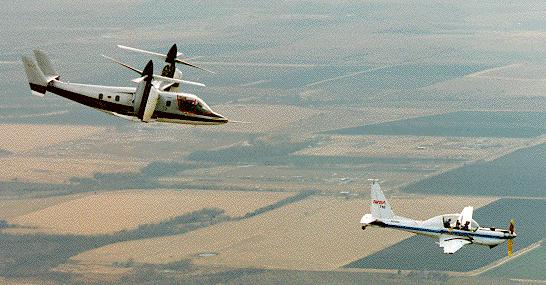In-Flight Rotorcraft Acoustics Program
XV-15 Flight & Wind Tunnel Tests

The XV-15 following the YO-3A in formation flight.
Background
Under NASA's Short Haul Civil Tiltrotor (SHCT) program, an extensive amount of acoustic measurements will be acquired from model and full-scale tiltrotors in wind tunnels. Tiltrotor blades are more highly twisted and loaded than conventional helicopter blades and therefore have different performance and noise characteristics. The wind tunnel tests are critical for understanding the aeroacoustics of tiltrotors.
One of the planned wind tunnel tests included a full-scale rotor from the XV-15 tiltrotor. A single XV-15 rotor is being tested in the 80- by 120-ft test section of the National Full-Scale Aerodynamics Complex (NFAC), with the rotor mounted on the Rotor Test Apparatus (RTA). Although the rotors are identical, the RTA is very different from the actual aircraft, hence limited acoustic measurements of the XV-15 in flight were necessary to provide a validation of the wind tunnel measurements. Therefore, acoustic data were acquired prior to the wind tunnel test using the YO-3A flying in formation with the XV-15 aircraft.
Flight Test
IRAP tests were performed with the YO-3A and XV-15 flying from the Bell Helicopter Flight Test Center in Arlington, Texas. Four flights were performed with the YO-3A and XV-15 flying in close formation, as shown in the photo. The flight conditions and microphone location were chosen to measure the most prominent BVI noise. The starboard wingtip microphone of the YO-3A was positioned 20 degrees below the right rotor hub at a rotor azimuth of 150 degrees. The distance between the starboard wingtip microphone and the rotor hub was three rotor diameters (75 feet). Target flight conditions included tip Mach number of 0.69, advance ratios of 0.156 and 0.185 (hence, 70-85 knots airspeed), rotor weight coefficient of 0.0111, and descent rates of 300-1100 ft/min, all with the XV-15 nacelles at 90 degrees (helicopter mode), where BVI is expected to be maximum. (In the photo shown here, the nacelles are at 80 degrees for convenience during the photo session.)
Wind-tunnel test
The results of the flight test were used to determine appropriate test conditions for a test of the XV-15 rotor in the 80- by 120-ft NFAC test section. A microphone was placed in a location geometrically identical to the relative position of the YO-3A starboard microphone and XV-15 rotor during flight. Rotor test conditions -- including forward airspeed, tip speed, rotor torque, angle of attack, and gimbal angle (equivalent to tip-path-plane angle) -- were all measured in real time during the IRAP flights and were duplicated during the wind-tunnel tests. Hence, the rotor state at each wind-tunnel test point matched that at the equivalent flight condition as closely as is possible for a wind tunnel test.
More information on the XV-15 wind-tunnel test can be found here. Detailed information on the 80- by 120-ft wind tunnel and RTA can be found here.
Related Publications:
McCluer, M. and Dearing, M. "Measuring Blade-Vortex Interaction Noise Using the YO-3A Acoustics Research Aircraft." 22nd European Rotorcraft Forum, Brighton, UK, September 1996.
See also the IRAPreferences page. A general history of the XV-15 is given in Maisel, M. D., Giulianetti, D. J., and Dugan, D. C. "The History of the XV-15 Tilt Rotor Research Aircraft From Concept to Flight." NASA SP-2000-4517, 2000.
Point of Contact:
C. W. Acree
NASA Ames Research Center
Moffett Field CA 94035-1000